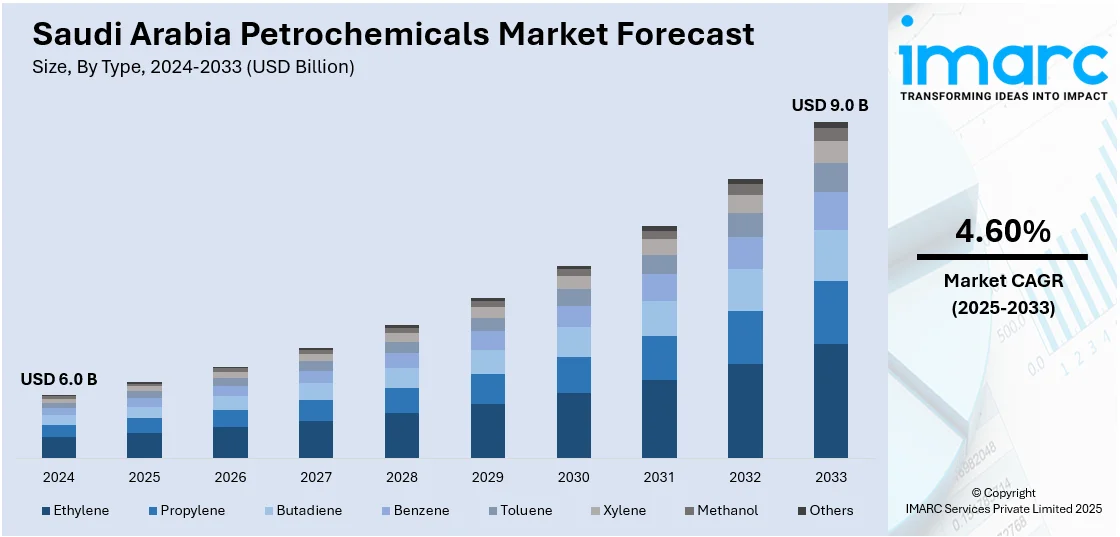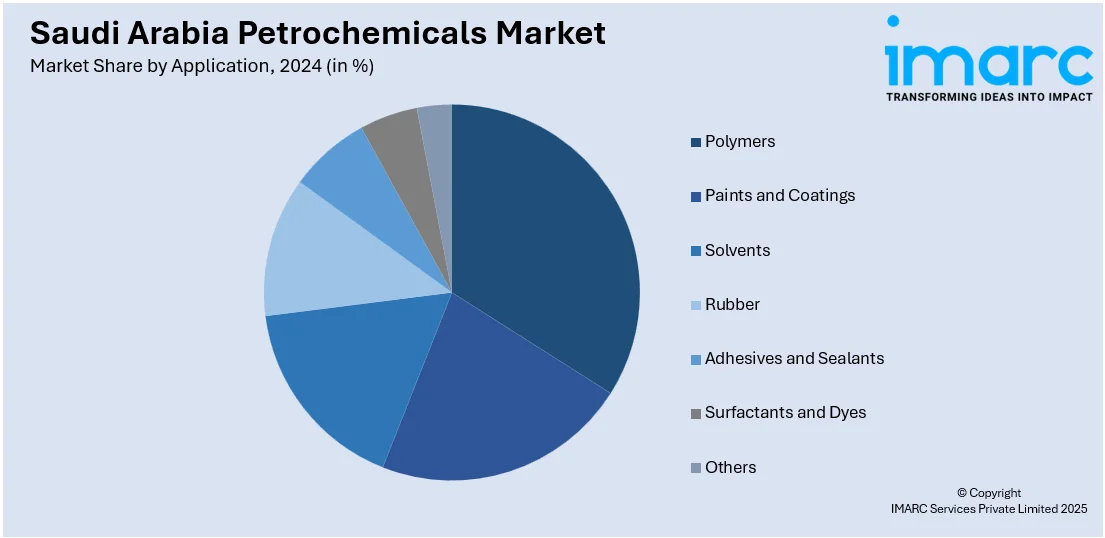
Saudi Arabia Petrochemicals Market Size, Share, Trends and Forecast by Type, Application, End Use Industry, and Region, 2025-2033
Saudi Arabia Petrochemicals Market Overview:
The Saudi Arabia petrochemicals market size reached USD 6.0 Billion in 2024. Looking forward, IMARC Group expects the market to reach USD 9.0 Billion by 2033, exhibiting a growth rate (CAGR) of 4.60% during 2025-2033. The market is driven by abundant hydrocarbon resources, integration with refining, and investments in value-added chemicals. Government initiatives like Vision 2030 encourage industrial diversification, while global demand for plastics and specialty chemicals boosts exports. Sustainability efforts, including circular economy adoption and hydrogen development, further strengthening the Saudi Arabia petrochemicals market growth.
|
Report Attribute
|
Key Statistics
|
|---|---|
|
Base Year
|
2024
|
|
Forecast Years
|
2025-2033
|
|
Historical Years
|
2019-2024
|
| Market Size in 2024 | USD 6.0 Billion |
| Market Forecast in 2033 | USD 9.0 Billion |
| Market Growth Rate 2025-2033 | 4.60% |
Saudi Arabia Petrochemicals Market Trends:
Expansion of Downstream Petrochemical Production
Saudi Arabia’s petrochemical sector, with a revenue exceeding 310 billion Saudi Riyals ($82.7 billion), accounts for nearly 80% of the Gulf Cooperation Council's petrochemical revenue. The sector is transitioning from basic chemicals to higher-value downstream products, driven by investments in specialty chemicals, plastics, and advanced polymers. This shift is aligned with the growing global demand for high-performance materials across industries like automotive, electronics, and packaging. Leading companies like SABIC and Aramco are diversifying portfolios by integrating refining with petrochemical production, optimizing feedstock efficiency. This trend aligns with Saudi Vision 2030's emphasis on industrial diversification and value addition. Strategic joint ventures with international partners further improve technology uptake and market access, enhancing Saudi Arabia's role as a prime supplier of sophisticated petrochemical products, while increasing its economic resilience along with Saudi Arabia petrochemicals market share.

Growing Investments in Hydrogen and Ammonia Production
Saudi Arabia is utilizing its petrochemical capabilities to diversify into the hydrogen and ammonia sectors, especially for blue and green hydrogen. With substantial natural gas resources and renewable capacity, the country is increasing scale-up plans for low-carbon ammonia production for export, most notably to Asia and Europe. Firms like Aramco and NEOM are investing in large scale hydrogen plants in order to claim dominance in the next energy universe. The thrust is aligned with global decarbonization patterns, with hydrogen emerging as a primary fuel substitute for industries and transportation. With growing demand for clean sources of energy, Saudi Arabia's petrochemical industry is primed to be at the forefront of providing hydrogen-based fuels to overseas markets.
Shift Towards Sustainability and Circular Economy
The embracing sustainable practices to meet global environmental regulations and corporate sustainability goals is positive impacting the Saudi Arabia petrochemicals market outlook. This shift involves investments in green technologies, carbon capture, and waste-to-value initiatives. Companies like SABIC are leading the way, with SABIC operating the world’s largest carbon capture and purification plant, capturing 500,000 metric tons of CO₂ annually from ethylene glycol production. This CO₂ captured is reused as feedstock, lowering emissions. There is also increasing use of low-carbon hydrogen and bio-based chemicals to minimize production emissions. Government policies to enhance energy efficiency and carbon neutrality reinforce these initiatives. These sustainability practices not only increase Saudi Arabia's international competitiveness but also place international investors, who are interested in environmentally conscious supply chains, in the sector, thus setting up the sector for long-term expansion with more stringent environment regulations.
Saudi Arabia Petrochemicals Market Segmentation:
IMARC Group provides an analysis of the key trends in each segment of the market, along with forecasts at the region level for 2025-2033. Our report has categorized the market based on type, application and end use industry.
Type Insights:
- Ethylene
- Propylene
- Butadiene
- Benzene
- Toluene
- Xylene
- Methanol
- Others
The report has provided a detailed breakup and analysis of the market based on the type. This includes ethylene, propylene, butadiene, benzene, toluene, xylene, methanol, and others
Application Insights:

- Polymers
- Paints and Coatings
- Solvents
- Rubber
- Adhesives and Sealants
- Surfactants and Dyes
- Others
A detailed breakup and analysis of the market based on the application have also been provided in the report. This includes polymers, paints and coatings, solvents, rubber, adhesives and sealants, surfactants and dyes, and others.
End Use Industry Insights:
- Packaging
- Automotive and Transportation
- Construction
- Electrical and Electronics
- Healthcare
- Others
The report has provided a detailed breakup and analysis of the market based on the end use industry. This includes packaging, automotive and transportation, construction, electrical and electronics, healthcare, and others.
Regional Insights:
- Northern and Central Region
- Western Region
- Eastern Region
- Southern Region
The report has also provided a comprehensive analysis of all the major regional markets, which include Northern and Central, Western, Eastern, and Southern Region
Competitive Landscape:
The market research report has also provided a comprehensive analysis of the competitive landscape. Competitive analysis such as market structure, key player positioning, top winning strategies, competitive dashboard, and company evaluation quadrant has been covered in the report. Also, detailed profiles of all major companies have been provided.
Saudi Arabia Petrochemicals Market News:
- In March 2025, Saudi Arabia’s Ministry of Energy approved feedstock allocation for two new petrochemical complexes in Jubail. Sipchem and LyondellBasell plan a joint project featuring a mixed feed cracker with a capacity of 1.5mn t/yr of ethylene and 1.8mn t/yr of polymers. Separately, Tasnee received approval for a complex producing 3.3mn t/yr of PE, MTBE, and specialty chemicals. The Tasnee project targets a Q4 2030 launch, while Sipchem’s timeline remains undisclosed.
- In March 2025, Saudi Aramco and TotalEnergies are developing the Amiral petrochemical complex in Jubail, Saudi Arabia, with a $11 billion investment. Integrated with the SATORP refinery, the project includes a 1.65 Mt/yr ethylene steam cracker and aims to enhance petrochemical production from advantaged feedstocks. Construction began in 2023, with operations set for 2027. The joint venture is owned by Aramco (62.5%) and TotalEnergies (37.5%), aligning with their long-term growth strategy.
Saudi Arabia Petrochemicals Market Report Coverage:
| Report Features | Details |
|---|---|
| Base Year of the Analysis | 2024 |
| Historical Period | 2019-2024 |
| Forecast Period | 2025-2033 |
| Units | Billion USD |
| Scope of the Report |
Exploration of Historical Trends and Market Outlook, Industry Catalysts and Challenges, Segment-Wise Historical and Future Market Assessment:
|
| Types Covered | Ethylene, Propylene, Butadiene, Benzene, Toluene, Xylene, Methanol, Others |
| Applications Covered | Polymers, Paints and Coatings, Solvents, Rubber, Adhesives and Sealants, Surfactants and Dyes, Others |
| End Use Industries Covered | Packaging, Automotive and Transportation, Construction, Electrical and Electronics, Healthcare, Others |
| Regions Covered | Northern and Central Region, Western Region, Eastern Region, Southern Region |
| Customization Scope | 10% Free Customization |
| Post-Sale Analyst Support | 10-12 Weeks |
| Delivery Format | PDF and Excel through Email (We can also provide the editable version of the report in PPT/Word format on special request) |
Key Questions Answered in This Report:
- How has the Saudi Arabia petrochemicals market performed so far and how will it perform in the coming years?
- What is the breakup of the Saudi Arabia petrochemicals market on the basis of type?
- What is the breakup of the Saudi Arabia petrochemicals market on the basis of application?
- What is the breakup of the Saudi Arabia petrochemicals market on the basis of end use industry?
- What is the breakup of the Saudi Arabia petrochemicals market on the basis of region?
- What are the various stages in the value chain of the Saudi Arabia petrochemicals market?
- What are the key driving factors and challenges in the Saudi Arabia petrochemicals?
- What is the structure of the Saudi Arabia petrochemicals market and who are the key players?
- What is the degree of competition in the Saudi Arabia petrochemicals market?
Key Benefits for Stakeholders:
- IMARC’s industry report offers a comprehensive quantitative analysis of various market segments, historical and current market trends, market forecasts, and dynamics of the Saudi Arabia petrochemicals market from 2019-2033.
- The research report provides the latest information on the market drivers, challenges, and opportunities in the Saudi Arabia petrochemicals market.
- Porter's five forces analysis assist stakeholders in assessing the impact of new entrants, competitive rivalry, supplier power, buyer power, and the threat of substitution. It helps stakeholders to analyze the level of competition within the Saudi Arabia petrochemicals industry and its attractiveness.
- Competitive landscape allows stakeholders to understand their competitive environment and provides an insight into the current positions of key players in the market.
Need more help?
- Speak to our experienced analysts for insights on the current market scenarios.
- Include additional segments and countries to customize the report as per your requirement.
- Gain an unparalleled competitive advantage in your domain by understanding how to utilize the report and positively impacting your operations and revenue.
- For further assistance, please connect with our analysts.
 Inquire Before Buying
Inquire Before Buying
 Speak to an Analyst
Speak to an Analyst
 Request Brochure
Request Brochure
 Request Customization
Request Customization




.webp)




.webp)












